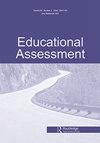Patterns of Solution Behavior across Items in Low-Stakes Assessments
IF 2.3
Q1 EDUCATION & EDUCATIONAL RESEARCH
引用次数: 26
Abstract
ABSTRACT The trustworthiness of low-stakes assessment results largely depends on examinee effort, which can be measured by the amount of time examinees devote to items using solution behavior (SB) indices. Because SB indices are calculated for each item, they can be used to understand how examinee motivation changes across items within a test. Latent class analysis (LCA) was used with the SB indices from three low-stakes assessments to explore patterns of solution behavior across items. Across tests, the favored models consisted of two classes, with Class 1 characterized by high and consistent solution behavior (>90% of examinees) and Class 2 by lower and less consistent solution behavior (<10% of examinees). Additional analyses provided supportive validity evidence for the two-class solution with notable differences between classes in self-reported effort, test scores, gender composition, and testing context. Although results were generally similar across the three assessments, striking differences were found in the nature of the solution behavior pattern for Class 2 and the ability of item characteristics to explain the pattern. The variability in the results suggests motivational changes across items may be unique to aspects of the testing situation (e.g., content of the assessment) for less motivated examinees.低风险评估中项目间的解决方案行为模式
摘要:低风险评估结果的可信度在很大程度上取决于考生的努力程度,这可以通过考生使用解决方案行为(SB)指数在项目上投入的时间来衡量。因为SB指数是为每个项目计算的,所以它们可以用来了解考生的动机在测试中是如何随项目变化的。潜在类别分析(LCA)与来自三个低风险评估的SB指数一起使用,以探索项目之间的解决方案行为模式。在测试中,受欢迎的模型由两类组成,第一类以高度一致的解决方案行为为特征(>90%的受试者),第二类以较低且不太一致的解决方式行为(<10%的受试人)。额外的分析为两个班的解决方案提供了支持性的有效性证据,两个班在自我报告的努力、考试成绩、性别构成和考试背景方面存在显著差异。尽管三项评估的结果大致相似,但在第2类解决方案行为模式的性质和项目特征解释该模式的能力方面发现了显著差异。结果的可变性表明,对于动机较低的考生来说,项目之间的动机变化可能是测试情况的各个方面(例如评估内容)所特有的。
本文章由计算机程序翻译,如有差异,请以英文原文为准。
求助全文
约1分钟内获得全文
求助全文
来源期刊

Educational Assessment
EDUCATION & EDUCATIONAL RESEARCH-
CiteScore
3.20
自引率
6.70%
发文量
24
期刊介绍:
Educational Assessment publishes original research and scholarship on the assessment of individuals, groups, and programs in educational settings. It includes theory, methodological approaches and empirical research in the appraisal of the learning and achievement of students and teachers, young children and adults, and novices and experts. The journal reports on current large-scale testing practices, discusses alternative approaches, presents scholarship on classroom assessment practices and includes assessment topics debated at the national level. It welcomes both conceptual and empirical pieces and encourages articles that provide a strong bridge between theory and/or empirical research and the implications for educational policy and/or practice.
 求助内容:
求助内容: 应助结果提醒方式:
应助结果提醒方式:


